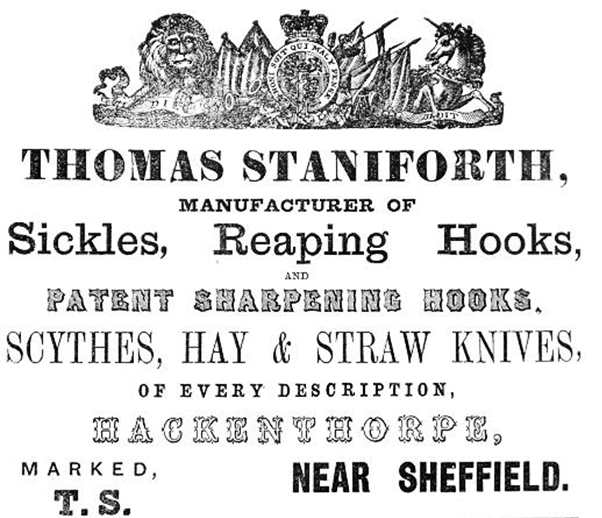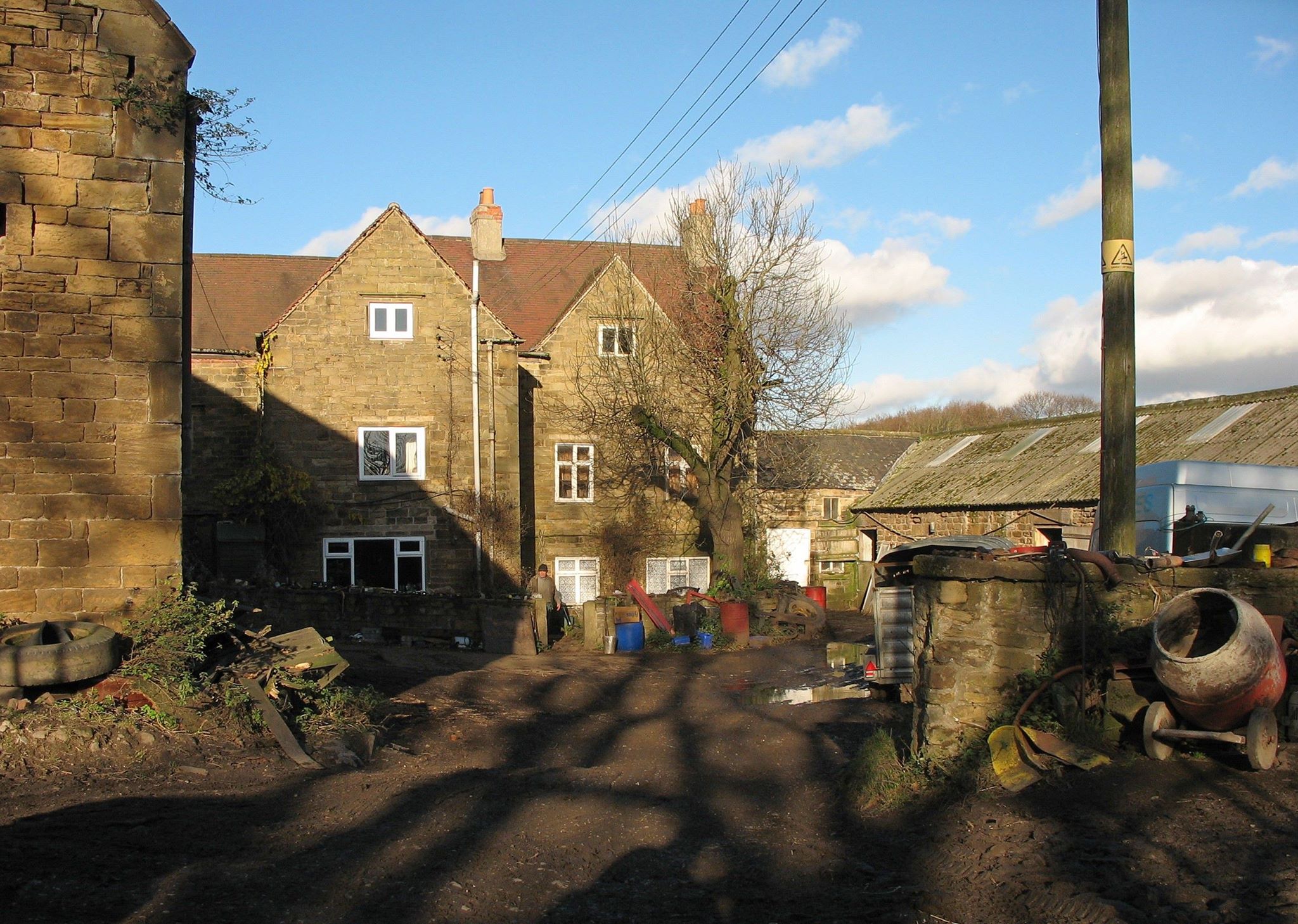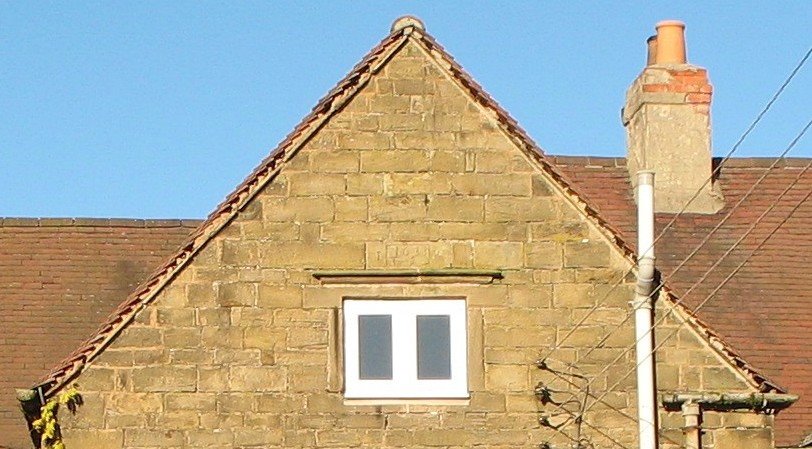
Thomas Staniforth & Co. Sickle works at Hackenthorpe.
 Bramley Hall in 2017
Bramley Hall in 2017
Bramley Hall is a large residence and farmhouse in the hamlet of Bramley, in the parish of Eckington, Derbyshire. The hamlet itself is, and mostly always has been, little more than a collection of farms, however Bramley Hall Farm itself has had a longstanding connection with the Staniforth family. Although the history of the building has never been recorded in any publication, we are able to piece together some of the story using deeds and other records.
The late historian T.L Platts left some brief notes on the Staniforth family that resided at Bramley:
In 1540 William Staniforth was residiing at Bramley Hall .
In 1563, James Staniforth was there, this James is mysterious as he does not appear on the parish records, however there is a deed that makes reference to him:
A Special Commission was appointed on 19th June, 1583, and Depositions were taken at Rotherham on 20th August, as to a beck called Norbeck, in the parish of Eckington, and a corn mill there, which were possibly to the injury of Her Majesty's mills and iron smithies on the same stream. The complainants were Henry Lord Hunsden and others, the defendants were James Lynacre, Esquire and James Stannyforth. The interrogatories on behalf of Lord Hunsden were 16 in number, the first witness was'- John Bromelye of Mosborough in the Countye of Derby yeoman of the age of threescore & seven yeares or thereatroutes sworne examined deposeth & saith :- To the 1 interrogatione he saithe he knoweth the brooke mention in the said interrogative. To the 2 interr. he saith that James Lynnaker one of the defendants hathe erectyd a water corne mylle within the manor of Eckingtone aboute a yeare or more by paste uppon the broke called Norbeck. To the 3 interr. he saithe that the sayd water corne mylne nere bye erectyd by the sayd james Lyunaker is distant from the queens maties mylne & from Smythys by estimacion a myle or ther aboutes as this deponent thinketh. To the 4 interr. he saithe yt the sayd James Lynnaker hathe caused to be made a great heade or banke of earthe & stones uppon the sayd water or broke whereupon the newlie erectyd mylne dothe stand, whereby there is a great dam of water gathering of & stayed. To the 5 interr. he saithe that the queens matte hathe one tenement & certen groundes thereto belonginge parte whereof doth adjoyne to the water callyd Norbecke when the sayd dam is newlie erectyd & made. To the 6 interr. he saithe that parte of her maties groundes belonginge to the sayd tenement are ower flown dyvers tymes by gatheringe and stayinge of the waters within the sayd damme so made by the sayd J. L. To the 7 interr. he saithe that the sayd J. L. hathe attached his newly erectyd dam hear unto one parcell ol grounde called the Holme adjoyninge to the sayd brok & water. To the 8 interr, this examinant cannot depose. To the 9 interr. he saithe that by reason of the makinge of the newe dam & erectynge of the sayd milne wherein the water is or may be retayned & kept sometymes by the space of three weekes together in some season & the occupyers & farmers of her maties sayd Iron Smythies and corne mylne cannot take the benefitt ot the streame of water as heartofore hathe bene accustomyd. To the 10 interr. he saithe that he knowethe her maties farmers, tenants; & occupiers to be greatly prejudiced & hynderyd by the stayinge & keeping of the water, To the 11 interr. he saithe he dothe not knowe any mentyon of Iron Smythies to be there but by showe of certain heapes of Synders lyinge near To the 12 intterr. he saithe there is within the manor of Eckingtone & dyvers others great heapes of Synders wch by appearance. never went by water but by fote or horse . . as this deponent verely thinketh for that there is not anye adjoyninge water to the sayd heapes of Cynders. To the 13 interr. he saithe that the capitall messuage callyd Plumley is within the manor of Eckington & is holden of the sayd manor by knight's service, & this he knoweth to be true for that George Lynnaker, grandfather to the sayd James Lynnaker one of the defendants, dyd confesse to this deponed and William Greves & others in Eckingtone churche beinge of the jury at the entry of Leonatd Dakers that he dyd hold this sayd capitall messuage of Plumley & other landes of the manor of Eckingtone aforesaid by the fourthe part of a knight's fee, And the lyke this examinent hathe sworne in dyvers court roules & other witnesses [It is. obvious that this was a case of a manor court being held in the nave of a church ; a by no means infrequent occurrence]. To the 14 interr. he saithe that he hathe knowen the most part of his lletyme that all the owners, farmers, & occupiers of the sayd house of Plumley hathe usyt & bene accustomyd to grynd all ther corne & grayne wch they grew uppon the sayd tenement at her sayd maties mylnes within the sayd manor of Eckingtone, unto nowe of late that James Lynnaker one of the defendants, hathe withdrawen their sute from the queenes maties sayd mylnes & hathe grounde Anie corne at the newe erectyd mylne. To the 15 interr. he saith he cannot depose further. To the 16th interr. he can not depose.
Thomas Staniforth of Bramley Hall left the hall to his son and heir, Thomas Staniforth. The elder Thomas left a will in 1614. This Thomas also has a son named William Staniforth, described as being 'Of Staveley'. William had a son named Thomas who was also described as being 'Of Staveley'. Thomas married Troth Widdowson of Chesterfield on July 14th 1627.
It is worth noting that an engraving appears on the exterior wall showing the initials 'T.S' along with the date '1638'. In the notes by T.L Platts he notes that in 1638 an ornate plaste moulding was placed over the mantlepiece which extended to the ceiling. The piece incorporated the initials TS and AS 1638 and was surrounded by dolphins, mermaids, birds and vine leaves.
In the notes of the late historian Rosamund Du Cane, she left two handwritten pedigree charts related to Bramley. The first begins with Thomas Staniforth buried 28 January 1616, however the second line begins with Thomas Staniforth of Bramley, Yeoman who appears on the Vileins Freeholders list of 1633. this Thomas is supposed to have married Anne Watts, daughter of Arthur Watts of Dronfield at North Wingfield. It is unsure how these lines link, however through the various mentions of their offspring in wills and court rolls, it is clear to see there were two lines of Staniforths at Bramley. The Engraving T.S/A.S is likely Thomas Staniforth and his Wife Ann (nee Watts).
 T.S 1638 Engraving
T.S 1638 Engraving
Although the house was reconstructed by Thomas in 1638, the hall is said to be of ancient origin. T.L Platts notes that the plaster on a bedroom wall was removed, it revealed a wall of wattle and daub. There was also a family connection between the Brights of Dore, as one of Thomas Staniforth 1615's great-grandfaughters Elizabeth Staniforth married Godfrey Bright. It is also noted that the hall bears similarity to Carbrook Hall, and Renishaw Hall in terms of it's plaster features.
Samuel Staniforth of Bramley, Yeoman, son of George Staniforth and Martha Turner (Who in turn was son of Thomas Staniforth and Anne Watts), married Sarah Staniforth, daughter of William Staniforth of Attercliffe, Hardwareman. It is noted that Samuel had a Memorial inscription in the aisle of Eckington Church, however this seems to have worn away over the years.
In 1716, Another Samuel Staniforth of Bramley Hall cut one and a half acres of spring wood, presumable for charcoal, on his copyhold estate. He also cut 4 oaks and 6 birks (birch trees). Samuel's eldest son Samuel was living in 1725.
On December 2nd 1731, their eldest son Samuel Staniforth of Bramley Grange marries Jane Jermyn, daughter of John Jermyn of Drake House at Clowne, Derbyshire. This Samuel is mentioned in the will of George Staniforth of Litfield in 1732, however he passes away before him. His intentory is taken 7 July 1739. Samuel and Jane had a daughter, Jenny Staniforth, baptised 2 February 1737, and was left in the guardianship of Thomas Jermyn. Samuel was said to have a brother William Staniforth, a Periwig maker that settled at Atterclfife, he died in 1745/1746.